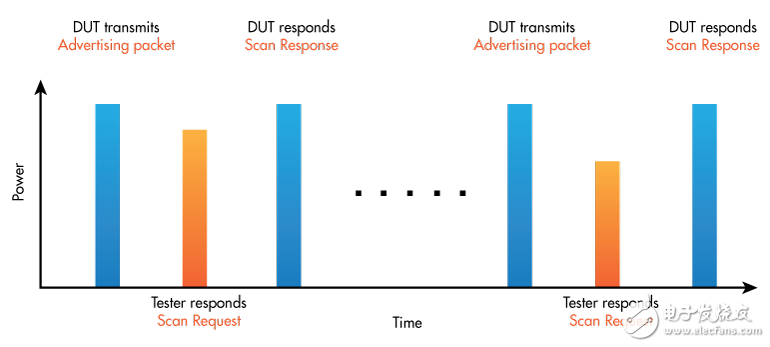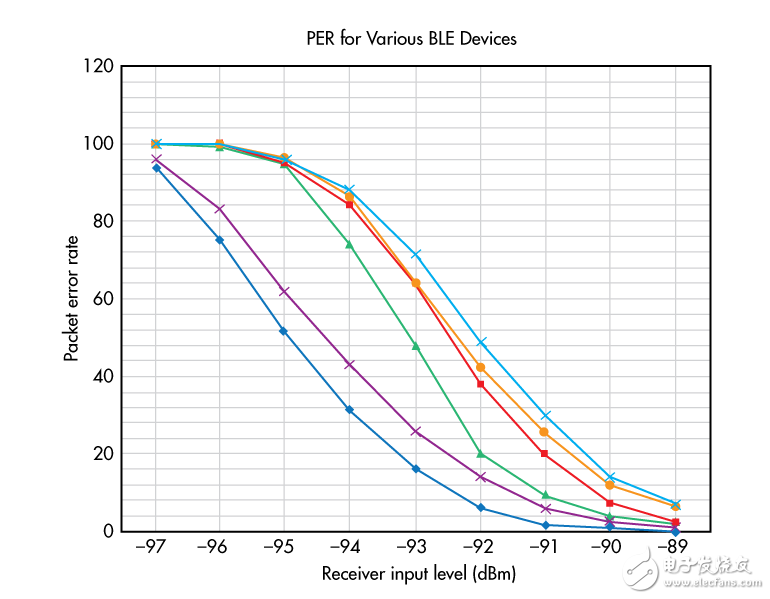Wireless performance verification problem solution for Bluetooth low energy OTA test system
Currently, Bluetooth Low Energy (BLE) is rapidly becoming one of the most widely deployed wireless technologies, and is widely used in various applications such as asset tracking, fitness monitoring, location services, and remote sensing. BLE devices are typically small, rugged, and often fully encapsulated in a protective enclosure to protect them from the environment. This package design presents a special challenge for design engineers and test engineers: how to perform wireless performance verification without any RF or digital connections? One solution is to use the wireless (OTA) BLE test, which provides fast parametric verification of transmitter and receiver performance. It is well known that transmitters and receivers are equally important, but for BLE devices, it is particularly difficult to verify the OTA performance of the receiver, and a new measurement method is needed. This article explores several new measurement techniques designed to determine BLE OTA packet error rate (PER) and receiver sensitivity. Challenge 1: In a typical non-OTA test, a digital communication method such as a UART or USB connection is required to control the device under test (DUT). When performing receiver testing, the device is first placed in a state ready to receive packets, and then the test system sends a known number of packets, and then the device is queried to determine the number of packets it successfully received. The test system will use this information to calculate PER, which is the standard method used by the industry to quantify receiver performance. In OTA testing, there is no direct connection communication, so the challenge is to design a new way to determine if the packet is received correctly. Solution 1: To determine the PER without using a wired connection, the OTA test solution must utilize standard BLE wireless protocol messages to determine if a packet was received. BLE devices transmit data using three specific broadcast frequencies distributed over the 2.4 GHz band. 1: The figure above shows the power consumption versus time for BLE broadcast, scan request, and scan response events. A device equipped with a receiver will listen for a specific BLE message named Scan_Request in a short time after sending a broadcast packet. This message is usually sent by a device that is nearby to communicate with the broadcast device. If the broadcast device receives this Scan_Request message, it will respond with a Scan_Response message. The power consumption versus time graph in Figure 1 reflects this pattern. The broadcast device first sends a broadcast packet (indicated in blue), the nearby station then issues a Scan_Request message (indicated in orange), and the broadcast device then issues a Scan_Response message (still indicated in blue). This message exchange occurs in the normal operation of BLE devices, and the OTA test system uses this behavior to measure PER. During the receiver test, the DUT first sends a broadcast packet, and then the test system sends a Scan_Request message, and if the DUT receives the packet, it will reply with a Scan_Response message. The test system will track the number of Scan_Requests sent and the number of Scan_Responses received, and use this information to calculate the receiver PER. When making sensitivity measurements, the test system determines the level of the RF that produces the particular PER by adjusting the RF signal level. This RF level is a general method of reflecting the quality of the receiver and is called receiver sensitivity. This method of using the broadcast packet Scan_Request message and the Scan_Response message not only accurately determines the PER or sensitivity of the receiver, but also does not require any direct wired communication with the DUT, which is the method used by the BLE OTA tester. Challenge 2: BLE has a lower data transfer rate than other common wireless technologies such as Wi-Fi or cellular networks. A large number of data packets are required in the receiver test to ensure that the measurement results are accurate and statistically significant. Due to the low data transfer rate, BLE receiver testing in production environments often takes a long time, resulting in a significant increase in cost. Undoubtedly, this method of long test time and higher cost is not desirable, so the second major challenge is to design a new measurement method that can accurately determine PER compared to existing traditional PER test methods. It can greatly reduce the number of packets used. Solution 2: To determine receiver sensitivity, it is often necessary to measure PER at a range of RF levels. The Bluetooth SIG (Organization for the development of Bluetooth performance specifications) stipulates that 1,500 packets must be used to measure receiver sensitivity. If the above broadcast method is used, a typical BLE device often takes several minutes at each level to receive so many packets. Moreover, if measurements are taken at multiple RF levels, a full receiver sensitivity test can take more than 10 minutes. This is obviously not suitable in many applications, so it is necessary to find a new and faster method. To solve this problem, the OTA test solution must use an algorithm to quickly determine the PER distribution curve. This method is called the "fast PER test" and is designed to quickly determine the receiver sensitivity when producing 50% PER. During the fast PER test, the tester first sends a single packet (Scan_Request) at any RF level. After the packet is acknowledged, the RF level is lowered and the next packet is sent at this lower new level. If the packet is not answered, the RF level is raised and the next packet is sent at this higher level. The tester uses an intelligent algorithm to adjust the step size of the RF level and record the acknowledgment and unacknowledged levels to quickly and accurately plot the "packet rate profile" with a minimum number of packets. Figure 2 shows the traditional PER curve for a BLE device. The PER curve is most sensitive to RF level changes at the 50% point of the curve, so the fast PER algorithm searches for this 50% point. During the RF level change, most of the packets are sent at an RF level close to 50%; since the algorithm converges on this 50% region, the RF level step size is also adjusted to a smaller value. This DUT receiver sensitivity measurement method is very accurate and repeatable, and requires a small number of data packets, compared to the traditional brute force PER scanning method that uses a large number of data packets at a range of different RF levels. The required number of packets is less than 5%. RF designers need to use the final design to verify the performance of deliverables, not just board-level measurements. The measured RF performance of board-level measurements can deviate significantly from the true state of the finished product. Test engineers often do not have the ability to use board-level RF and digital connections during the manufacturing process, so they need to use wireless quick test methods to get accurate and repeatable results. The OTA BLE test solution helps technicians effectively address these key challenges in measurement. With these systems, engineers can build better designs while manufacturers can use parametric data to verify manufacturing quality. For BLE devices, once good wireless communication is not available, the device will not function properly, so wireless performance is critical. Today, these BLE OTA test solutions will help people design better products while helping manufacturers create products that meet their requirements. With more than 15+ yrs rich MFG experience, you can definitely trust in and cooperate with. infrared thermometers wholesale, forehead thermometer wholesale,wholesale thermometer suppliers TOPNOTCH INTERNATIONAL GROUP LIMITED , https://www.itopnoobluetoothes.com


Provide you with the supply of Personal Protective Equipment. to help you safely get back to your daily routine.
Our products include pulse Oximeter Finger, Forehead Thermometer, Automatic foam soap dispenser, etc.
Our strict quality control protocol thoroughly vets every aspect of production, storage, and shipments all the way way to our end customers.